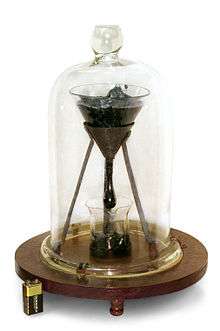Pitch (resin)

Pitch is a name for any of a number of viscoelastic polymers. Pitch can be natural or manufactured, derived from petroleum, coal tar[1] or plants. Various forms of pitch may also be called tar, bitumen or asphalt. Pitch produced from plants is also known as resin. Some products made from plant resin are also known as rosin.
Pitch was traditionally used to help caulk the seams of wooden sailing vessels (see shipbuilding). Pitch may also be used to waterproof wooden containers and in the making of torches. Petroleum-derived pitch is black in colour, hence the adjectival phrase, "pitch-black".
Viscoelastic properties
Naturally occurring asphalt/bitumen, a type of pitch, is a viscoelastic polymer. This means that even though it seems to be solid at room temperature and can be shattered with a hard impact, it is actually fluid and will flow over time, but extremely slowly. The pitch drop experiment taking place at University of Queensland is a long-term experiment which demonstrates the flow of a piece of pitch over many years. For the experiment, pitch was put in a glass funnel and allowed to slowly drip out. Since the pitch was allowed to start dripping in 1930, only nine drops have fallen. It was calculated in the 1980s that the pitch in the experiment has a viscosity approximately 230 billion (2.3×1011) times that of water.[2] The eighth drop fell on 28 November 2000, and the ninth drop fell on 17 April 2014.[3] Another experiment was begun by a colleague of Nobel Prize winner Ernest Walton in the physics department of Trinity College in Ireland in 1944. Over the years, the pitch had produced several drops, but none had been recorded. On Thursday, July 11, 2013 scientists at Trinity College caught pitch dripping from a funnel on camera for the first time.[4]
The viscoelastic properties of pitch make it the vehicle of choice for polishing high-quality optical lenses and mirrors. In use the pitch is formed into a lap or polishing surface, which is charged with iron oxide or cerium oxide. The surface to be polished is pressed into the pitch, then rubbed against the surface so formed. The ability of pitch to flow, albeit slowly, keeps it in constant uniform contact with the optical surface.
Production
The heating (dry distilling) of wood causes tar and pitch to drip away from the wood and leave behind charcoal. Birchbark is used to make birch-tar, a particularly fine tar. The terms tar and pitch are often used interchangeably. However, pitch is considered more solid, while tar is more liquid. Traditionally, pitch that was used for waterproofing buckets, barrels and small boats was drawn from pine. It is used to make Cutler's resin.
See also
References
- ↑ COAL-TAR PITCH, HIGH TEMPERATURE
- ↑ The Pitch Drop Experiment
- ↑ Biever, Celeste; Lisa Grossman (17 April 2014). "Longest experiment sees pitch drop after 84-year wait". New Scientist. Retrieved 23 June 2014.
- ↑ "Trinity College experiment succeeds after 69 years". RTÉ News. 24 July 2013. Retrieved 23 June 2014.
